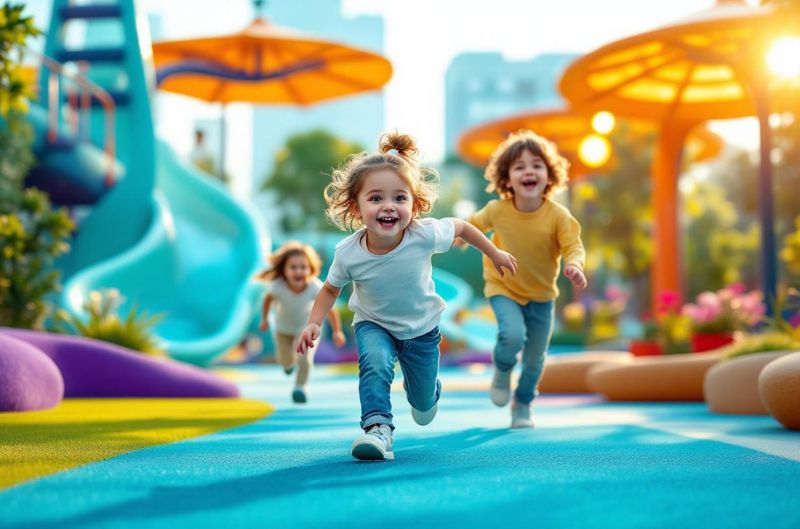
Top Trends in Playground Safety Surfacing 2025
Author: Austin Stanfel
The top trends in playground safety surfacing for 2025 focus on creating safer, more inclusive, and sustainable environments for children. The industry is seeing continuous innovation in both materials and design strategies to mitigate injuries and promote multisensory play experiences.
Rubberized Surfacing Innovations
Rubber surfacing, particularly poured-in-place systems and rubber tiles, remains a leading choice due to its superior shock absorption, durability, and design versatility. Modern poured-in-place (PIP) surfacing can be customized on-site with colored recycled rubber, enabling vibrant graphics, themed play areas, and accessibility features that make spaces wheelchair-friendly. These surfacing types require less maintenance than loose-fill options and offer long-term protection against weather and wear, making them ideal for high-traffic parks and schools.
- Recycled rubber tiles and mulch support sustainability efforts and provide diverse color and pattern options.
- Poured-in-place surfaces can be shaped to accommodate creative designs, logos, and interactive games, enhancing both aesthetics and play value.
Synthetic Turf Safety Surfaces
Synthetic turf is now one of the fastest-growing playground surfacing options, valued for its accessibility, realistic appearance, and low maintenance requirements. Some products are specifically designed for playground applications to ensure proper drainage, impact absorption, and compliance with ADA standards.
- Synthetic turf offers a lush, green look year-round and eliminates the upkeep required of natural grass, making it attractive for community parks.
- Advances in turf technology include antibacterial treatments and improved surface stability.
Engineered Wood Fiber and Rubber Mulch
Engineered wood fiber (EWF) and rubber mulch remain popular due to their natural appearance and affordability, especially for budget-conscious projects. Both materials provide good shock absorption but require frequent maintenance to maintain depth consistency and ensure compliance with safety standards.
- EWF blends naturally into rustic or nature-inspired playground themes, reinforcing the connection to outdoor environments.
- Rubber mulch, made from recycled tires, supports sustainability while offering vibrant color choices for thematic playscapes.
Inclusive and Accessible Surfacing
Inclusivity extends far beyond ADA minimums in 2025, with surfacing designed to improve play experiences for children with a broad spectrum of abilities. Seamless surfaces like PIP rubber and synthetic turf accommodate mobility devices, while textured areas and color-coded zones support neurodiverse children and multisensory engagement.
- Designers now incorporate surface markings and custom graphics to guide movement, facilitate games, and make navigation easier for children with visual or cognitive challenges.
- Modular surfacing options allow for safe risk-taking and independence, helping children build confidence in a secure environment.
Sustainable and Nature-Inspired Materials
Sustainability has become a core value in playground surfacing design. Manufacturers are prioritizing recycled and biodegradable materials, eco-friendly installation methods, and site-sensitive product selection.
- Rubber surfacing made from recycled sneaker grind and tires reduces landfill waste and supports circular manufacturing practices.
- Combining modern surfacing with natural elements such as logs, boulders, and flower beds fosters ecological awareness and encourages imaginative play.
Technology Integration and Smart Surfaces
The most forward-looking playgrounds now incorporate innovative technologies into surfacing and equipment. These advancements include integrated sensors to monitor surface conditions, track impacts, and detect maintenance needs before hazards arise.
- Some designs feature interactive surface elements that respond to movement, supporting both physical engagement and playful learning.
Playground Safety Surfacing Comparison Table
| Surfacing Type | Safety | Accessibility | Maintenance | Sustainability | Design Versatility | Cost |
|---|---|---|---|---|---|---|
| Poured-in-Place Rubber | Excellent | High | Low | High | Excellent | Higher |
| Rubber Tiles | Good | High | Low | High | Good | Moderate |
| Synthetic Turf | Good | High | Low | Moderate | Good | Moderate |
| Engineered Wood Fiber | Good | Moderate | Moderate | Moderate | Moderate | Low |
| Rubber Mulch | Good | Moderate | Moderate | High | Good | Moderate |
Conclusion
Top trends in playground safety surfacing for 2025 include rubberized unitary surfaces, synthetic turf, and eco-friendly materials, all designed to maximize safety, inclusivity, accessibility, and creativity. Communities and designers are prioritizing surfaces that support not only physical play but also ecological education, multisensory engagement, and the well-being of every child. These innovations are reshaping the playground industry toward resilient, inspiring, and safer environments for the next generation.

